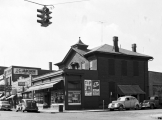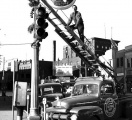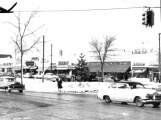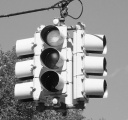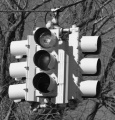|
|
| Line 50: |
Line 50: |
| | Today, many intersections are getting complete overhauls to fit the demands in traffic these days. Federally approved flashing yellow arrow left turn signals are now replacing the Michigan flashing red ball lefts. Most LEDs used in the area are Dialights, with some GE units here and there. All brand new intersections support DuraSigs or poly LFEs for vehicle signals, and continue to use DuraSigs for pedestrians signals. Although Eagle developed a 16 inch pedestrian signal that is used here for countdown pedestrian signals. Doghouse signals began appearing here for right turn movements. The top section being a Mark IV unit to prevent cracking. | | Today, many intersections are getting complete overhauls to fit the demands in traffic these days. Federally approved flashing yellow arrow left turn signals are now replacing the Michigan flashing red ball lefts. Most LEDs used in the area are Dialights, with some GE units here and there. All brand new intersections support DuraSigs or poly LFEs for vehicle signals, and continue to use DuraSigs for pedestrians signals. Although Eagle developed a 16 inch pedestrian signal that is used here for countdown pedestrian signals. Doghouse signals began appearing here for right turn movements. The top section being a Mark IV unit to prevent cracking. |
| | | | |
| − | While some aluminum T-Con heads (Nick? The boobie-back non ICC, non-Durasig signals) were still around and a few aluminum Eagles the majority of Macomb was Durasig intersections in both 8" and 12" varieties, everything yellow. Generally 12" were used overhead and 8" were used, if at all, for side-of-pole signals along with two-stacked 12" black Durasig pedestrian signals. Much had been converted to LEDS, often with the ped having a dual indication hand/man LED in one section and the other left non functional. Countdown module conversions were rare. In the mid teens, major cooridors along Macomb county, such as Ryan Road, recieved full upgrades, including signal poles, ped poles, and ADA setback requirements, and conversion to either box span or mast arm configurations with flashing yellow arrow left turns in lieu of the traditional diagonal spanwire setups with a flashing red ball for left turns. The equipment installed was slightly more diverse and many new intersections went completely with yellow 12" Econolite "buttonback" poly heads, no side of pole signals, and 16" black countdown peds. | + | While some aluminum T-Con heads (Nick? The boobie-back non ICC, non-Durasig signals) were still around and a few aluminum Eagles the majority of Macomb was Durasig intersections in both 8" and 12" varieties, everything yellow. Generally 12" were used overhead and 8" were used, if at all, for side-of-pole signals along with two-stacked 12" black Durasig pedestrian signals. Much had been converted to LEDS, often with the ped having a dual indication hand/man LED in one section and the other left non functional. Countdown module conversions were rare. In the mid teens, major corridors along Macomb county, such as Ryan Road, recieved full upgrades, including signal poles, ped poles, and ADA setback requirements, and conversion to either box span or mast arm configurations with flashing yellow arrow left turns in lieu of the traditional diagonal spanwire setups with a flashing red ball for left turns. The equipment installed was slightly more diverse and many new intersections went completely with yellow 12" Econolite "buttonback" poly heads, no side of pole signals, and 16" black countdown peds. |
| | </div> | | </div> |
| | | | |
| Line 115: |
Line 115: |
| | | | |
| | [[File:eamxdd.jpg|200px|thumb|left|MDOT shop: Testing EPAC 300 M30, EPIC and EPAC M50 controller units.]] | | [[File:eamxdd.jpg|200px|thumb|left|MDOT shop: Testing EPAC 300 M30, EPIC and EPAC M50 controller units.]] |
| | + | </div> |
| | + | |
| | + | == Wayne County Traffic Control History: Focusing on Detroit == |
| | + | |
| | + | === Signals === |
| | + | |
| | + | ==== 1920's ==== |
| | + | <div style="overflow: hidden"> |
| | + | |
| | + | </div> |
| | + | |
| | + | ==== 1930's - 1940's ==== |
| | + | <div style="overflow: hidden"> |
| | + | |
| | + | </div> |
| | + | |
| | + | ==== 1940's ==== |
| | + | <div style="overflow: hidden"> |
| | + | |
| | + | </div> |
| | + | |
| | + | ==== 1950's ==== |
| | + | <div style="overflow: hidden"> |
| | + | |
| | + | </div> |
| | + | |
| | + | ==== 1960's - 1970's ==== |
| | + | <div style="overflow: hidden"> |
| | + | |
| | + | </div> |
| | + | |
| | + | ==== 1980's - Today ==== |
| | + | <div style="overflow: hidden"> |
| | + | |
| | </div> | | </div> |
Macomb County Traffic Control History (Part of the Detroit Tri-Counties Region)
Signals
1920's - 1930's
Essco – first to appear in mt. Clemens, the county seat. This picture shows the Essco model R-4. This signal was produced around 1925.
Tokheim – first to be used in pedestal and side-of-pole installs. Both of these configurations used solid-body adjustable signals. Four ways were used to replace the Esscos and were installed on diagonal spanwires in the late 1930s.
Mt. Clemens Installation, Macomb County Library Cooperative
Mt. Clemens Installation, Macomb County Library Cooperative
1940's - 1960's
Eagle ornamental Eagleluxes were used in the first overhead clusters during the early 1940s however production of this signal ceased in the mid 1930's. Conventional Eagle Eaglelux "Tall Fin" KB-x form signals were used through the remainder of the 1940s and 1950s for most of Macomb County’s installs.
The Eagle Sentry, aka rodded flatback, was used after the production run of Eagleluxes ceased sometime around 1958. The solid-section eagle, known as the conventional flatback, was introduced around 1967 and was widely used until eagle launched its line of polycarbonate signals in the mid 1970s.
Econolite – was used by the county sporadically during the mid fifties and early 1960s. Complete installs of Econolite always featured eagle pedestrian signals. Econolite heads and clusters would usually be seen as replacements for eagle heads to be removed due to damage or age.
Eagle Ornamental Eagleluxes, Nine Mile Road at Gratiot Ave. in East Detroit, Macomb County Library Cooperative
Eagle Sentry or Rodded Flatback, Photo by Joe C.
Econolite Short Groove Signal, Photo by Joe C.
1970's - 2000's
The first polycarbonate signals appeared in the late 1970s and were Eagle Durasigs. Combo clusters like the ones shown were common where 12" signals were needed on main arterials.
Intersections in the Metro Detroit area changed quite a bit from the late 80s/early 90s till today. During the 90’s we used nearly all Eagle equipment. The signal heads themselves were DuraSig and most controllers were EPIC 140s,EF 140s, or older EPAC 300s housed in slightly smaller NEMA cabinets. Most modern intersections that were replacing the aluminum signals were two yellow 12 inch DuraSig clusters, with a case sign in the middle of a diagonal span wire. Auxiliary 8 inch yellow DuraSigs usually mounted on poles or pedestals along with black 12 inch DuraSig pedestrian signals. The cabinet usually mounted to one of the signal poles. Most intersections in the area at this time, with the exception of Oakland County, had a pretimed setup. No detection of any kind were used in many of the early to mid 90s displays.
In the mid 90s, more intersections were getting left turn signal upgrades. The earliest Left turns signals were back to back two ways for the major street and a “left only” sign in between them for the minor street. Most didn’t do the Michigan red ball flash sequence until a short time later. When left turn signals like these were used, intersections were usually equipped with two three way clusters and two single facers, both facing different directions and the side signals on the three ways facing the minor street. Later on intersections, especially major ones, sported four way clusters for Left turns, with two sets of two way clusters for the thru traffic. Right turn movements were displayed using a single section signal and a right turn arrow. These were wired to the left turn phase’s Phase On connection on the controller. That way, while the left turn phase was active/on (Green arrow, yellow arrow, and all red clearance) of the side street, the right signal on a main street would be on. All these signals were DuraSig and yellow, and on diagonal wire spans, for the most part.
In the later half of the 90’s and up until today Macomb County in particular began switching from using DuraSig vehicle signals to LFE poly models. The LFE polys, which are currently being made by Eagle, started popping up. It is unknown why the change was necessary. It may have been cheaper. Pedestrian signals continued to be black Eagle DuraSigs. LEDs of different brands were showing up around this time. Dialight eventually became the main brand used in the Metro Detroit area.
2010 - Present
Today, many intersections are getting complete overhauls to fit the demands in traffic these days. Federally approved flashing yellow arrow left turn signals are now replacing the Michigan flashing red ball lefts. Most LEDs used in the area are Dialights, with some GE units here and there. All brand new intersections support DuraSigs or poly LFEs for vehicle signals, and continue to use DuraSigs for pedestrians signals. Although Eagle developed a 16 inch pedestrian signal that is used here for countdown pedestrian signals. Doghouse signals began appearing here for right turn movements. The top section being a Mark IV unit to prevent cracking.
While some aluminum T-Con heads (Nick? The boobie-back non ICC, non-Durasig signals) were still around and a few aluminum Eagles the majority of Macomb was Durasig intersections in both 8" and 12" varieties, everything yellow. Generally 12" were used overhead and 8" were used, if at all, for side-of-pole signals along with two-stacked 12" black Durasig pedestrian signals. Much had been converted to LEDS, often with the ped having a dual indication hand/man LED in one section and the other left non functional. Countdown module conversions were rare. In the mid teens, major corridors along Macomb county, such as Ryan Road, recieved full upgrades, including signal poles, ped poles, and ADA setback requirements, and conversion to either box span or mast arm configurations with flashing yellow arrow left turns in lieu of the traditional diagonal spanwire setups with a flashing red ball for left turns. The equipment installed was slightly more diverse and many new intersections went completely with yellow 12" Econolite "buttonback" poly heads, no side of pole signals, and 16" black countdown peds.
Controllers
The Solid-State Era
First Generation

EF-140 controller unit. Photo from Signalfan
Macomb County initially wanted a solid state controller that mimicked the mechanical controllers due to the unusual timing/cycling patterns of Michigan intersections. While common to Michiganders it was virtually unheard of outside the state to have a flashing red left turn signal, decades before the "flashing yellow arrow" made a national debut. This feature was originally available on EPIC units and eventually added as a feature on EPAC controller units. In addition, when this red left turn signal was green the perpendicular traffic would have a single section green right turn arrow that would just turn off, no yellow or red phases present to follow. This was an extra interval step on EPICs, phase on input for the cross streets left phase when using EPAC.
The reversed sequence...thrus cycled first then left turns on most cases. (Nonstandard interval sequences allowed this on EPIC. Alternate sequences and phase pair reversal created this scenario on the EPAC. On phase oriented machines like the EPAC, lefts are odd numbered phases and thru's are even. With reversals set, phase sequence would be 2,1,4,3 or thru, left, thru, left) NEMA phase-oriented machines at the time did not provide as many options and flexibility as they do nowadays.
According to Scott Holzhei of MDOT (user "Kentron" on STF): Eagle Signal was the only manufacturer willing to develop an interval based machine.
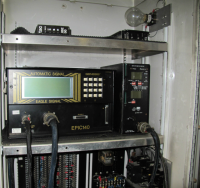
Macomb County standard: EPIC140 in Eagle Size 4 cabinet
First model developed: EF140, interval based machine that was non-NEMA oriented. Individual timed intervals were mapped to specific outputs. Housed in an Eagle Size 4 (G) NEMA cabinet and worked with EDI conflict monitors and TSC load switches. The controller front panel connectors were not NEMA spec’ed
The menu driven model, EPIC140, used the same connectors and cabinet interface, but was menu driven and had more flexible programming. Options included four separate signal plans, time base clock, and pre-emption.
Both the EF and EPIC140 units were sold nationwide but only seen significant usage in Michigan.
EPIC140 controllers with EDI conflict monitors, housed in Eagle Size 4 pole-mounted cabinets became the standard controller used. It allowed for flexible timing and sequences including the flashing red left and single section right turn arrows, pre-timed time-of-day changes.
EPIC140s were also installed in Eagle Size M pole and base mount, M36 and P base mount cabinets and along most major corridors until recently.
Actuated signals were not common in Macomb County during the 90s and early 2000s except for low volume side streets and (rare) left turns. Where detection and more complicated programming was needed, EPIC140s were substituted with EPAC300 M30s.
EPICs fell by the wayside as intersections became more complex with TS2 detection, wireless broadband interconnection and as NEMA machines became more flexible.
Second Generation
The first wave of modernization included EPAC300 M42s in base mount size P Eagle cabinets running TS2 Type 2. Eventually EPAC M50s made their mark. Iteris vantage video detection was standard. Some intersections began seeing Cohu survelliance cameras. First one I seen was at the intersection of Metro Parkway and Schoenherr. Flashing yellow arrows/boxspans, etc became standard for upgrades. Diagonal spans still common.
Third Generation

Intelight 2070 in existing Eagle cabinet on Mound Road replaced in 2013 with an ITS 340 cabinet.
The second wave of modernization replaced corridors with 2070 equipment from Intelight. Mound Road was the first to be upgraded, but Schoenherr Road, and Hayes quickly followed. Video was primarily replaced with “Intersector” microwave sensors from MS Sedco most likely for better accuracy. More equipment such as video surveillance and GPS equipment became standard.
Some intersections had the 2070 equipment installed in the existing Eagle cabinet, others had their cabinets either removed, splice boxes installed, or used the old cabinet as a splice box. A large ITS cabinet with four access doors was installed for control. Microwave and radar detection became more common.
Fourth Generation
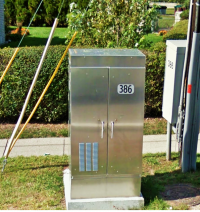
Intelight 340 ITS cabinet and disconnected Eagle Size 4 cabinet serving as a splice point.
The third wave of modernization included most new intersections to be spec’ed with ITS cabinets standard, either Intelight or Siemens, possibly Econolite and McCain as well but haven’t seen evidence of their usage.
The four 340 ITS cabinets on the bid list for Macomb County were Intelight, Siemens, Econolite and McCain.
ITS cabinets allowed for more flexible software capabilities, more inputs and outputs for other equipment at the intersection, and faster processing speeds for PC, remote control. Road Commission of Macomb County spec
The first ITS cabinets installed were Intelight brands
As of October 2008, MDOT timing specifications allow for EF/EPIC and EPAC controllers for State-Maintained roads. MDOT Spec
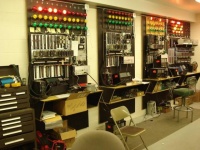
MDOT shop: Testing EPAC 300 M30, EPIC and EPAC M50 controller units.
Wayne County Traffic Control History: Focusing on Detroit
Signals
1920's
1930's - 1940's
1940's
1950's
1960's - 1970's
1980's - Today

